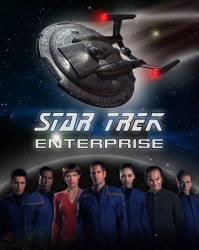Corrected entry: Whenever a shuttlepod leaves Enterprise, two wings deploy on either side. In reality, these wings, because they are so thin, would burn up in a planet's atmosphere. This is done to show that Enterprise-era technology is less advanced than Kirk-era technology.

Star Trek: Enterprise (2001)
1 corrected entry in show generally
Other mistake: Two Borg are discovered North of the Arctic Circle. One is covered in ice, the other encased in ice. Carbon dating shows the wreckage to be over 100 years old (to tie it in with Star Trek: First Contact). The Borg are inactive and unable to repair themselves until they are "defrosted". The temperature above the Arctic Circle doesn't usually drop below -100°F. The Borg have been shown to work very well in the vacuum of space which is 3-4K (roughly -454°F). If they can survive that, even being frozen in a solid block of ice would not slow them down. The nanites have to be in their "blood" and operate at the cellular level. That cannot be damaged by re-entry and the crash.
Captain Archer: We should be entering the nebula.
Subcommander T'Pol: The readings could be misleading.
Captain Archer: As Dr. Phlox would say - optimism.
Subcommander T'Pol: Optimism doesn't alter the laws of physics.
Trivia: A film reference to Star Trek: First Contact: Archer says something about a group of cybernetic creatures (The Borg), that tried to stop Cochrane from launching his mission into space that was stopped by a group of humanoids, that were also from the future (USS Enterprise NCC 1701-E).
Question: Why was Enterprise cancelled after only four seasons?
Answer: While ratings did drop, there was a lot going on to cause the rating drops and cancellation. First, "Enterprise" was on UPN, which was dissolved a year after the show was cancelled. At the time of cancellation, it was UPN's highest rated drama. Because they were on at night, they were often preempted by local UPN broadcast of baseball games. And it wasn't even aired in every market. They also lost a major corporate backer early and it was difficult for them to over come that loss. Plus, for season 4, they switched to a Friday night line up, so they were competing against Fox shows, like "The Simpsons" whereas on Wednesdays they didn't have much competition.
Answer: The same reason any show gets canceled, low ratings.
Not all shows get cancelled because of low ratings. Some get cancelled because they're too expensive to make.
Don't know why it had low ratings. IMO it was close to the best of Star Trek franchise.





Correction: As we don't know what the wings are made of, we can hardly state that they should burn up in the atmosphere. And as the shuttles make controlled entrances to planetary atmospheres, unlike the uncontrolled method used by current space vehicles, the flight velocity could be adjusted to keep the heat lower anyway.
Tailkinker ★